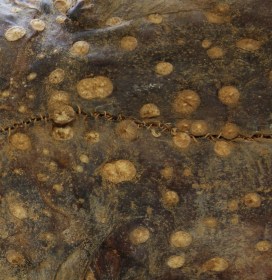Solving a prickly mystery…

by Mark Carnall, Life Collections manager
Visitors to the Museum often comment on just how many things there are to see here, but in fact only a small percentage of the collection is on public display – less than 0.1%. The remaining 99.9% is held in storage for use in research, teaching and to loan to other museums and universities.
I receive hundreds of enquiries from researchers all over the world who are interested in many aspects of animal biology. In exchange for our information about the skeletons, skins, specimens preserved in fluid, nests, shells and taxidermy here, the Museum gets knowledge from world experts who are publishing new science.

One such recent enquiry, from researchers Dr Samuel Iglésias and Frederik Mollen, concerned the Bramble or Spinous Shark (Echinorhinus brucus). You may not have heard of the Bramble Shark – it’s an enigmatic bottom-of-the-sea dwelling species – but this is one of the reasons why the researchers are trying to track down all known specimens held in European institutions.

Bramble Sharks are so called because of the large thorn-like structures, called dermal denticles, that cover the skin. These sharks are thought to be once common in European waters but are now virtually extinct.
I checked the Museum databases and stores and found 14 Bramble Shark specimens in the collections: one taxidermy specimen; one set of jaws with skin; a section of skin; and 11 fluid-preserved dissections. Unfortunately, as is often the case in older natural history collections, the fluid specimens did not have data associated with them – information such as age, locality, who collected them, what the dissections were or who dissected them.
After passing images and this list of specimens to the researchers they sent through an 1875 paper titled The Brain and Cranial Nerves of Echinorhinosus spinosus with notes on the other viscera by Bruce Clarke and the excellently named Hatchett Jackson. This paper describes the dissection of two specimens at the University of Oxford, one of which was a female collected from Penzance on 15 February 1875.
Armed with this new information I was able to cross-reference this dissection with some of our archives to confirm that most of the dissected specimens actually came from this single female shark collected in 1875, which was dissected and the parts used in illustrations in a technical publication.

Another discovery came while photographing the skin specimen, and comparing it to the other dry specimens. It became clear that the thorns of the skin were very different to the typical Bramble Shark arrangement and it turned out that the skin was in fact from a Porcupine Ray (Urogymnus asperrimus).
The happy ending here is that the researchers now have better information for their publication and these specimens will be put ‘on the map’ in the technical literature for other researchers to access.
Although the Museum collections are effectively one Bramble Shark down (but up one Porcupine Ray skin), we do now have better information about the age, locality, relationship, identification, citation in the literature, and history of some these specimens. This makes them even more useful for research in the future.
Not all enquiries end with such a deeply satisfying result, but it is certainly nice when they do.


